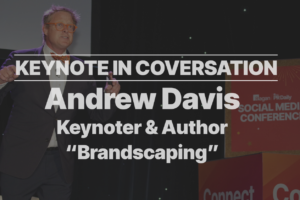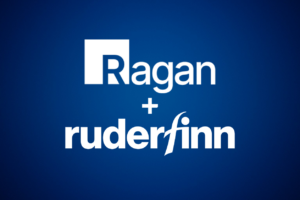How to build your AI doppelganger as an assistant, not a replacement
Author Andrew Davis kicked off Ragan’s 2024 Social Media Conference with a keynote on how new tech shapes marketing strategies.

During Ragan’s Social Media Conference at Walt Disney World in Orlando this week, hundreds of communicators gathered to hear from some of the business’s brightest and most innovative minds. To kick off the festivities, Andrew Davis, author of “Brandscaping”, addressed the crowd of hundreds with advice for communicators and social pros on how to dive into a brave new world of generative AI and understand the impacts of emerging tech on the comms space.
A helpful assistant, not a replacement
Even though the Social Media Conference took place in the Most Magical Place on Earth, Davis said that you can’t wave a magic wand with AI as he remembered one of the first times he experimented with ChatGPT, when he asked the software, to sum up the concept of marketing in one sentence.
“Chat GPT tells me that marketing is like explaining your favorite toy to your friends so they’ll want to play with it too,” he said. “Damn! That would have taken me a week to come up with.”
Davis highlighted the sometimes volatile relationship that communicators have with AI, emphasizing that what we get out of AI has a lot to do with the human checks behind the AI use process.
“Maybe AI isn’t a tool at all, but a cognitive collaborator,” Davis said. “Maybe if we want to get more out of AI, we need to put more of ourselves into it.”
Unlocking AI’s communications superpower
Social communicators who want to properly collaborate with AI should start by learning what it’s capable of in terms of content creation. Davis said that one of the most underutilized parts of a generative AI platform is its ability to mimic tone.
“Mimicry and imitation is really the superpower we should rely on to transform our relationship with AI,” he said.
He went on to describe the situation of the digital doppelganger, a concept in which communicators can leverage generative AI to create an avatar that generates messages virtually indistinguishable from something that came from the keystrokes of a person. Revealing his digital doppelganger, “Drewdini,” Davis emphasized that human oversight and input are still key.
“The byproduct of that process isn’t truly you, but it’s not generative AI or ChatGPT either — it’s somewhere in between,” he said.
AI as an extension of self
Davis then explained that the most important part of the communicator’s AI process isn’t the ideation, but the refining step. In that way, you can insert more of your own personality into your digital doppelganger so it’s better able to reflect your tone and intent.
“Take the best output that you get and copy it into your Google Doc,” Davis said. “Then edit that copy yourself. That way, you’re taking something that your doppelganger has created and editing it to teach it the sort of content that you’re really looking for.”
He also recommended that communicators frequently give back input to their AI platform of choice to help it learn style, tone, and messaging and be more consistently helpful.
“You need to think of it as either an extension of yourself or a close collaborator rather than a tool,” he said.
Transparency and trust with AI
Transparency and trust should serve as north stars for any social communicator in their day-to-day role. That doesn’t change when it comes to working with AI. Davis described what he called “the digital doppelganger paradox”, in which people hide the fact that they use AI.
“We use AI in secret,” he said. “All while can’t fathom others secretly using AI. In fact, 70%of workers are using ChatGPT at work — they’re just not telling their bosses.”
Communicators need to remember the importance of trust and transparency, particularly when they’re using AI. That means being clear and honest about it.
“Anytime we use our digital doppelganger to help us craft or distribute anything, we need to be transparent about it,” Davis said.
He also told the crowd that communicators should discuss AI as a partner, not a secret weapon for productivity that makes communicators more valuable, not less. But that value and trust are rooted in what we give to an AI collaborator.
“If you give a little of yourself, give a little of your brain, a little of your heart and have the courage to experiment, we all can transform the future of AI into something that makes us the future — and not the AI.”
Sean Devlin is an editor at Ragan Communications. In his spare time he enjoys Philly sports and hosting trivia.
COMMENT
Ragan.com Daily Headlines
RECOMMENDED READING
AI for communicators: What’s new and what’s next
Tags: social media conference







